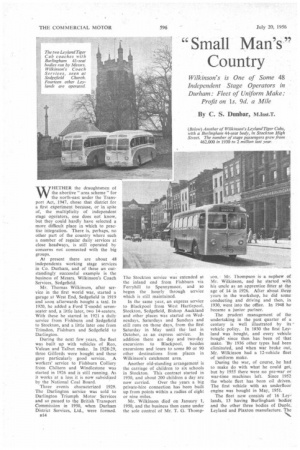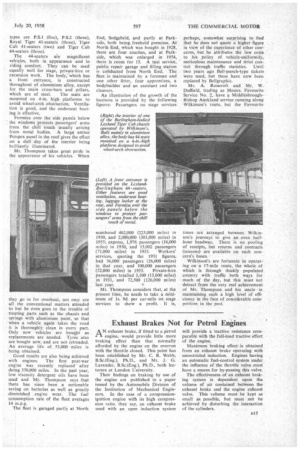"Small Man's" Country
Page 48

Page 49

If you've noticed an error in this article please click here to report it so we can fix it.
Wilkinson's is One of Some 48 Independent Stage Operators in Durham: Fleet of Uniform Make: Profit on is. 9d. a Mile
By C. S. Dunbar, M.inst.T.
WHETHER the draughtsmen of the abortive " area scheme" for the north-east under the Transport Act, 1947, chose that district for a first experiment because, or in spite of, the multiplicity of independent stage operators, one does not know, but they could hardly have selected a more difficult place in which to practise integration. There is, perhaps, no other part of the country where such a number of regular daily services at close headways, is still operated by concerns not connected with the big groups.
At present there are about 48 independents working stage services in Co. Durham, and of these an outstandingly successful example is the business of Messrs. Wilkinson's Coach Services, Sedgefield.
Mr. Thomas Wilkinson, after service in the first world war, started a garage at West End, Sedgefield in 1919 and soon afterwards bought a taxi. In 1920, he added a Ford T-model sevenseater and, a little later, two I4-seaters. With these he started in 1921 a daily service from Fishburn and Sedgefield to Stockton, and a little later one from Trimdon, Fishburn and Sedgefield to Darlington.
During the next few years, the fleet was built up with vehicles of Reo, Vulcan and Talbot make. In 1928-29, three Gilfords were bought and these gave particularly good service. A workers' service to Fishburn Colliery from Chiltern and Windlestone was started in 1926 and is still running. As it works at a loss it is now subsidized by the National Coal Board.
Three events characterized 1929. The Darlington service was sold to Darlington Triumph Motor Services and so passed to the British Transport Commission in 1950, when Durham District Services. Ltd., were formed.
1314
The Stockton service Wati extended at the inland end from Fishburn via Ferryhill to Spennymoor, and so began the hourly through service which is still maintained.
In the same year, an express service to Blackpool from West Hartlepool, Stockton, Sedgefield, Bishop Auckland and other places was started on Wednesdays, Saturdays and Sundays and still runs on those days, from the first Saturday in May until the last in October, as an express service. In addition there are day and two-day excursions to Blackpool, besides excursions and tours to some 80 or 90 other destinations from places in Wilkinson's catchment area.
Another old-standing arrangement is the carriage of children to six schools in Stockton. This contract started in 1930, and about 200 children a day are now carried. Over the years a big private-hire connection has been built up from points within a radius of eight or nine miles.
Mr. Wilkinson died on January 1, 1950, and the business then came under the sole control of Mr. T. G. Thomp son. Mr. Thompson is a nephew of Mr. Wilkinson, and he started with his uncle as an• apprentice fitter at the age of 14 in 1926. After about thre years in the workshop, he did some conducting and driving and then, in 1930, went into the office. In 1948 he became a junior partner.
The prudent management of the undertaking in the past quarter of a century is well illustrated by its vehicle policy. In 1930 the first Leyland was bought, and every vehicle bought since then has been of that make. By 1936 other types had been eliminated, and when war broke out, Mr. Wilkinson had a 12-vehicle fleet of uniform make.
During the war, of course, he had to make do with what he could get, but by 1955 there were no pre-war' or war-time machines left. Since 1952 the whole fleet has been oil driven. The first vehicle with an underfloor engine was bought in May, 1951.
The fleet now consists of 16 Leylands, 13 having B-urlingham bodies and the other three bodies of Duple, Leyland and Plaxton manufacture. The types arc P.S.1 (five), P.S.2 (three), Royal Tiger 41-seaters (three), Tiger Cub 41-seaters (two) and Tiger Cub 44-seaters (three).
The 44-seaters are magnificent vehicles, both in appearance and in riding comfort. They can be used equally well for stage, private-hire or excursion work. The body, which has a front entrance, is constructed throughout of aluminium alloy, except for the main cross-bars and pillars, which are of steel. The seats are mounted on 4-in, high platforms to avoid wheel-arch obstruction. Ventilation is good, and the underseat heating is effective.
Formica over the side panels below the windows protects passengers' arms from the chill touch usually arising from metal bodies. A largd amber Perspex panel in the roof gives the effect on a dull day of the interior being brilliantly illuminated.
Mr. Thompson takes great pride in the appearance of his vehicles. When
they go in for overhaul, not onty are all the conventional matters attended to but he even goes to the trouble of treating parts such as the chassis and springs with aluminium paint, so that when a vehicle again takes the road it is thoroughly clean in every part. Only new vehicles are bought as replacements are needed. Tyres also are bought new, and are not retreaded. An average life of 53,000 miles is being obtained.
Good results are also being achieved with engines. The first post-war eng:ne was recently replacedafter doing 350,000 miles. In the past year, low viscosity detergent oils have been used and Mr. Thompson says that there has since been a noticeable saving on batteries as well as greatly diminished engine wear. The fuel consumption rate of the fleet averages 14 m.p.g.
The fleet is garaged partly at North End, Sedgefield, and partly at Parkside, both being freehold premises. At North End, which was bought in 1928, there are four coaches, and at Parkside, which was enlarged in 1954, there is room for 15. A taxi service, public repair garage and filling station is cofiducted from North End. The fleet is maintained by a foreman and one other fitter, four apprentices, a bodybuilder and an assistant and two cleaners.
An illustration of the growth of the business is provided by the following figures: Passengers on stage services numbered 462,000 (223,000 miles) m 1930, and 2,080,000 (301,000 miles) in 1955; express, 1,976 passengers (16,000 miles) in 1930, and 15,002 passengers (71,000 miles) in 1955. Workers' services, quoting the 1931 figures, had 36,000 passengers (26,000 miles) in that year, and 100,000 passengers (52,000 miles) in 1955. Private-hire passengers totalled 3,100 (15,000 miles) in 1931, and 72,500 (126,000 miles)
last year. 4
Mr. Thompson considers that, at the present time, he needs to take a minimum of Is. 9d. per car-mile on stage services to show a profit. . It is,
perhaps, somewhat surprising to -find that he does not quote a higher figure in view of the experience of other concerns, but he attributes the low costs • to his policy of vehicle-uniformity, meticulous maintenance and strict control through traffic statistics. Until two years ago Bell-punch-type tickets were used, but these have now been replaced by Bellgraphic.
Mr. A. Roucroft and Mr, W. Duffield, trading as Messrs. Favourite Service No. 2, have a MiddlesbroughBishop Auckland service running along Wilkinson's route, but the Favourite
times are arranged between Wilkinson's journeys to give an -even halfhour headway. There is no pooling of receipts, but returns and contracts (seasons) are available on each concern's buses.
Wilkinson's are fortunate in operating on a 17-mile route, the whole of which is through thickly populated country with traffic both ways for much of the day, but this must not detract from the very real achievement of Mr. Thompson and his uncle in maintaining such a high level of efficiency in the face of considerable competition in the past.




































































































